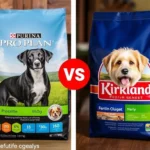
Dog nutrition is a fundamental aspect of pet ownership that directly influences the health and well-being of our furry companions. Just like humans, dogs require a balanced diet to thrive. With the fast-paced lifestyle many pet owners lead, ensuring that dogs receive proper nutrition can sometimes be a challenge. This is where best automatic dog feeders come into play, offering a convenient solution to meet your dog’s dietary needs.
Understanding Dog Nutrition
Importance of Proper Nutrition
Proper nutrition is crucial for dogs, impacting their overall health, energy levels, and longevity. Essential nutrients fall into five main categories:
- Proteins: Vital for growth, repair, and maintenance of body tissues.
- Fats: Provide energy and support cell structure.
- Carbohydrates: Offer a quick source of energy.
- Vitamins: Essential for metabolic processes.
- Minerals: Important for bone health and many bodily functions.
A balanced diet helps prevent obesity, promotes healthy skin and coat, and supports immune function. Feeding dogs the right mix of these nutrients can substantially enhance their quality of life.
Common Nutritional Needs by Dog Age
Nutritional needs vary significantly across different life stages:
- Puppies require higher protein and fat levels to support their rapid growth and development. They typically need a specially formulated puppy food that meets these energy demands.
- Adult dogs require a balanced diet that maintains their health and energy levels. This often includes a mix of proteins, fats, and carbohydrates tailored to their specific breed size and activity level.
- Senior dogs may need diets lower in calories but rich in fiber, along with supplements to support joint health and cognitive function.
Pregnant or nursing dogs have unique dietary needs as well, requiring increased caloric intake and specific nutrients to support the health of both the mother and her puppies.
Recognizing Nutritional Deficiencies
Signs of poor nutrition can manifest in various ways:
- Weight loss or obesity may indicate an imbalance in calorie intake.
- Poor coat condition, including excessive shedding or dullness, can suggest fatty acid deficiencies.
- Dental issues or bad breath might indicate insufficient bone or dental chews in their diet.
- Lethargy and lack of energy can result from inadequate nutrient levels.
Common deficiencies, such as a lack of essential fatty acids or certain vitamins, can lead to significant health issues if not addressed promptly.
The Role of Automatic Dog Feeders
What are Automatic Dog Feeders?
Automatic dog feeders are devices designed to dispense dog food at scheduled times and in specific portions. They come in various types, including:
- Gravity feeders: These rely on gravity to dispense food as the dog eats.
- Programmable feeders: These allow pet owners to set feeding times and portions, usually equipped with timers and programmable functions.
These feeders utilize technology to simplify the feeding process, making it easier for pet owners to maintain a consistent feeding schedule.
Benefits of Using Automatic Dog Feeders
Using automatic dog feeders offers several advantages:
- Convenience: They save time for pet owners, making it easier to manage feeding schedules even when busy.
- Consistency: Automatic feeders help ensure that dogs receive meals at regular intervals, which is essential for their digestive health.
- Portion control: They prevent overfeeding by dispensing precise amounts of food, reducing the risk of obesity, a growing concern among pets.
- Reducing anxiety: For dogs with separation anxiety, automatic feeders can help alleviate stress by providing a sense of routine even when their owners are away.
Choosing the Best Automatic Dog Feeder
Key Features to Consider
When selecting the best automatic dog feeder, consider these key features:
- Size and capacity: Choose a feeder that matches your dog’s size and eating habits. Larger dogs may require feeders with more capacity.
- Programmability: Look for models that allow you to schedule meals and adjust portion sizes to suit your dog’s needs.
- Material and design: Opt for durable, easy-to-clean materials that can withstand frequent use.
- Power source: Decide between battery-operated or plug-in options based on your home setup and preferences.
Top Recommendations for Automatic Dog Feeders
Here are some of the best automatic dog feeders available on the market today:
- PetSafe Healthy Pet Gravity Feeder
- Features: Adjustable portion sizes, easy to clean, and made of durable plastic.
- Pros: Simple design, no programming required.
- Cons: Limited control over portion sizes compared to programmable models.
-
Price Range: $30 – $50
-
WOPET Automatic Pet Feeder
- Features: Programmable feeding times, voice recorder for personalized messages, and a large capacity.
- Pros: Allows for multiple meals per day, great for busy schedules.
- Cons: Requires batteries or a power outlet.
-
Price Range: $70 – $100
-
PetFusion Ultimate Smart Pet Feeder
- Features: Wi-Fi enabled, app-controlled, and customizable meal sizes.
- Pros: Remote feeding capabilities and tracking of your dog’s eating habits.
- Cons: Higher price point, tech-dependent.
- Price Range: $130 – $200
User reviews indicate that each of these models is well-received, with owners praising their ease of use and effectiveness in maintaining a regular feeding routine for their pets.
Integrating Automatic Feeders into Your Dog’s Diet
Transitioning to an Automatic Feeder
Introducing an automatic feeder to your dog’s routine can be done in a few simple steps:
- Familiarization: Allow your dog to explore the feeder while it’s empty to reduce any anxiety or hesitation.
- Gradual Introduction: Start by using the automatic feeder alongside your current feeding method. Gradually transition to using only the automatic feeder.
- Consistency: Maintain a consistent schedule while your dog adjusts to the new feeding method.
Combining Automatic Feeders with Other Feeding Methods
While automatic dog feeders are convenient, they can be used in conjunction with other feeding practices. Consider these tips:
- Treats and Supplements: You can still provide treats or supplements separately, ensuring they are healthy and appropriate for your dog’s diet.
- Home-Cooked Meals: If you prepare home-cooked meals, you can adjust the automatic feeder’s portions to accommodate this, ensuring your dog gets a balanced diet.
Common Concerns and Misconceptions
Are Automatic Feeders Safe for Dogs?
Safety is a concern for many pet owners considering automatic feeders. These devices are generally safe when used correctly. To ensure a safe feeding experience:
- Monitor your dog’s health: Regularly check your dog’s weight and overall condition to ensure the feeding amounts are appropriate.
- Choose quality feeders: Invest in reputable brands that prioritize safety features, like secure lids and non-toxic materials.
Myths about Automatic Dog Feeders
Several misconceptions exist about automatic dog feeders:
- Myth: They promote overeating.
-
Fact: When programmed correctly, automatic feeders can help control portions and prevent overeating.
-
Myth: Dogs will become lazy and unactive.
- Fact: Proper feeding methods encourage healthy eating habits and do not inherently cause lethargy. Regular exercise remains essential.
Conclusion
Understanding dog nutrition is vital for ensuring the health and happiness of our pets. Using the best automatic dog feeders can enhance your dog’s diet by providing regular, controlled portions of food, ensuring that they receive the nutrition they need. By carefully selecting an automatic feeder that fits your dog’s needs and transitioning to it smoothly, you can simplify your pet care routine while promoting better health for your furry friend.
Investing in an automatic dog feeder is a step towards ensuring your dog receives the consistent, nutritious meals they deserve, making it a worthwhile addition to any pet owner’s toolkit.









